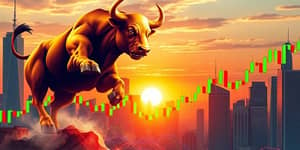
Financial markets often appear unpredictable, yet beneath the surface lie consistent patterns driven by human nature. Behavioral economics illustrates how emotions, mental shortcuts, and social influences steer investors away from rational decisions. By integrating psychology into economic theory, it exposes the true catalysts behind market bubbles, panics, and sustained trends.
Traditional economics rests on the Efficient Market Hypothesis (EMH) and the notion of “homo economicus”—a perfectly rational agent who always maximizes utility. However, real-world observations repeatedly contradict these assumptions. Researchers Daniel Kahneman and Amos Tversky revolutionized this field by introducing prospect theory, which shows that people value losses more intensely than gains of equal magnitude. Prospect theory explains why investors may reject favorable bets if they have experienced recent losses.
Moreover, decision making often relies on heuristics—mental shortcuts that simplify complex evaluations. While heuristics can speed judgment, they also introduce systematic errors when circumstances change or information is incomplete. Thaler’s concept of nudges further demonstrates how very small modifications in choice architecture can produce dramatic shifts in behavior without eliminating freedom of choice.
Overall, behavioral economics establishes that human psychology shapes economic outcomes through predictable patterns, challenging standard models that ignore cognitive factors.
Cognitive biases are the invisible forces that subtly sway decisions and market trajectories. Recognizing these tendencies is the first step toward mitigating their impact and designing more resilient strategies.
These biases often interact, creating feedback loops where initial errors trigger emotional responses that fuel further irrational behavior. For example, anchoring might set an unrealistic reference price, which then deepens loss aversion when markets diverge.
Market anomalies refer to patterns in stock returns that contradict the EMH. Behavioral economics provides a robust framework for understanding these occurrences as products of collective cognitive biases rather than pure chance or fundamental mispricing.
Three prominent anomalies include the January effect, momentum, and reversal patterns. Investors tend to act in predictable but irrational ways around these phenomena, offering both challenges and opportunities for market participants.
Institutional and individual investors can exploit these patterns by developing systematic strategies that account for behavioral drivers, rather than relying solely on fundamental analysis.
Behavioral insights extend far beyond academic theory; they underpin many marketing tactics and policy initiatives designed to steer decisions in desired directions. Thaler and Sunstein’s nudge theory exemplifies how minor adjustments can yield significant benefits at scale.
In finance, nudges are used to improve retirement savings. Auto-enrollment in 401(k) plans dramatically increases participation rates by changing the default option. Similarly, personalized risk assessments and interactive dashboards help investors recognize and adjust for their own biases, promoting more disciplined portfolio management.
The dot-com bubble of the late 1990s illustrates how optimism, herd behavior, and confirmation bias can drive valuations far beyond reasonable levels. Enthralled by the prospect of skyrocketing internet profits, investors poured capital into companies with minimal revenue or clear business models. When reality failed to meet expectations, the subsequent crash erased trillions in market value.
The 2008 Global Financial Crisis further underscores the dangers of systemic irrationality. Overconfidence in housing markets, complex mortgage-backed securities, and misaligned incentives led to widespread risk-taking. As property prices began to decline, loss aversion and the sunk cost fallacy delayed corrective action, deepening the downturn into a full-blown crisis.
These historical events highlight the importance of stress testing assumptions and maintaining disciplined risk controls. By understanding how biases accumulate and interact, financial professionals can design safeguards that prevent localized errors from cascading into global upheaval.
Recognizing and mitigating cognitive biases is essential for smarter investing and effective regulation. Portfolio managers can incorporate strategies that deliberately counteract herd behavior or momentum chasing, such as periodic rebalancing or trend-neutral overlays.
On the policy front, regulators now explore behaviorally informed measures like disclosure reforms, cooling-off periods, and improved financial literacy programs. Countries including the UK and the Netherlands have established dedicated behavioral insights teams to design public initiatives that account for real human behavior.
Ultimately, integrating behavioral economics into decision frameworks leads to more stable markets and protects investors from common pitfalls. It shifts the conversation from assuming rational actors to building systems that support human strengths and compensate for weaknesses.
The next frontier in behavioral finance lies at the intersection of artificial intelligence and big data. Machine learning models can analyze vast datasets to detect subtle patterns of bias-driven trades and sentiment shifts. These tools offer promise for early warning systems that flag emerging anomalies before they escalate.
Interdisciplinary collaboration will further enrich our understanding. Insights from neuroscience, psychology, and computer science converge to reveal the neural underpinnings of risk tolerance and decision-making under stress. Yet, these advances raise ethical questions. Powerful algorithms could be misused to exploit investor vulnerabilities or manipulate market sentiment.
Building transparent and accountable AI systems, rooted in ethical guidelines, will be critical. As markets evolve, the goal should be to enhance investor welfare through innovations that respect autonomy and promote informed choices.
Behavioral economics transforms our view of financial markets by illuminating the human factors underlying price movements and investment decisions. By acknowledging the inevitability of cognitive biases in finance, investors and policymakers can craft more resilient strategies that withstand emotional turbulence.
As individuals, cultivating self-awareness and ongoing education is vital. Whether through structured debiasing exercises, transparent data analytics, or thoughtfully designed nudges, the path to better outcomes lies in embracing our imperfections and learning to navigate them effectively.
In the end, thriving in the ever-changing market landscape depends not on aspiring to perfect rationality, but on mastering the art of decision making in the real world.
References













